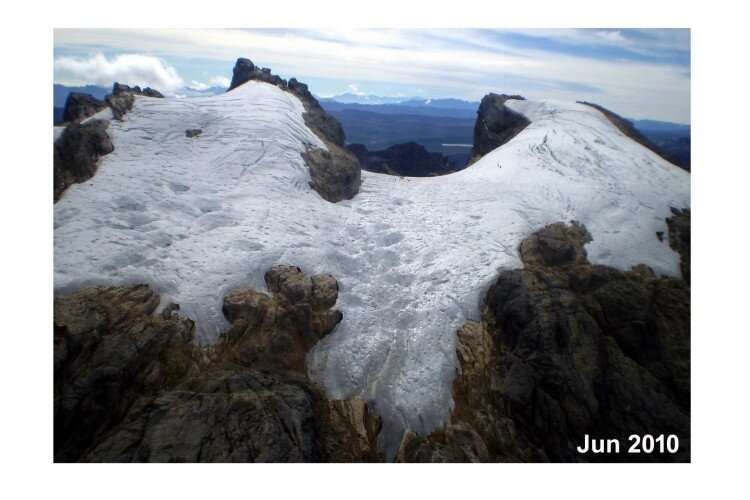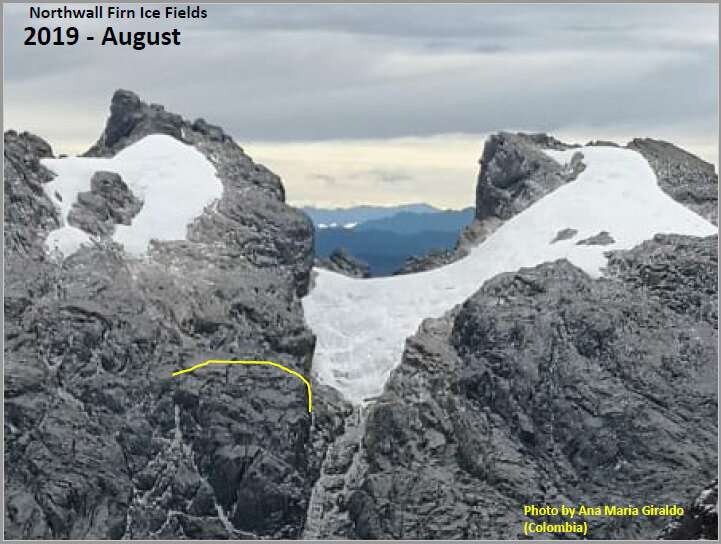Last remaining glaciers in the Pacific will soon melt away

The last remaining tropical glaciers between the Himalayas and the Andes will disappear in the next decade—and possibly sooner—due to climate change, a new study has found.
The glaciers in Papua, Indonesia, are "the canaries in the coal mine" for other mountaintop glaciers around the world, said Lonnie Thompson, one of the senior authors of the study published today in the Proceedings of the National Academy of Sciences.
"These will be the first to disappear; the others will certainly follow," said Thompson, distinguished university professor in the School of Earth Sciences and senior research scientist at the Byrd Polar and Climate Research Center at The Ohio State University.
The glaciers, atop a mountain near Puncak Jaya, on the western half of the island of New Guinea, have been melting for years, Thompson said. But that melt increased rapidly due in part to a strong 2015-2016 El Niño, a phenomenon that causes tropical ocean water and atmospheric temperatures to get warmer. El Niños are natural phenomena, but their effects have been amplified by global warming.
The study suggests that the glacier will disappear in the next 10 years, most likely during the next strong El Niño.
Thompson said it is likely that other tropical glaciers, such as those on Kilimanjaro in Tanzania and Quelccaya in Peru, will follow.

"I think the Papua, Indonesia, glaciers are the indicator of what's going to happen around the world," Thompson said.
Thompson and his team have been monitoring the glacier since 2010, when they drilled ice cores to determine the composition and temperature of the atmosphere around the glacier throughout history. Even then, the glacier was shrinking. That melt started at least 150 years ago, Thompson said, but has quickened in the last decade. The researchers found signs of melting at both the top of the glacier and at the bottom.
During the 2010 drilling expedition, the team installed a string of PVC pipe sections, connected by a rope, into the ice. Their idea was to measure how much ice had been lost by periodically measuring the rope sections left uncovered as the ice melted.
When the stake was measured in November 2015, about five meters of rope had been uncovered, meaning that the glacier surface was melting at a rate of about one meter per year. A team went back in May 2016, and saw that an additional approximately 4.26 meters of rope had been uncovered—a rapid increase in melting over just six months.
The team also measured the extent of the glacier's melt by measuring its surface area, which shrank by about 75 percent from 2010 to 2018. The ice field had shrunk so much that by 2016 it had split into two smaller glaciers. Then, in August 2019, a mountain climber scaling the peak took a photo of the glacier, showing its near disappearance.
"The glacier's melt rate is exponentially increasing," Thompson said. "It's similar to visiting a terminal cancer patient, and documenting the change in their body, but not being able to do anything about it."
Globally, glacier melt is a major contributor to sea level rise, which, along with warming ocean waters, can lead to more frequent and more intense storms.
Thompson said the mountaintop glaciers around the world contribute between a third and a half of the annual sea level rise in the Earth's oceans.
"They are much more vulnerable to the rising temperatures because they're small and they're warmer—they're closer to the melting threshold," he said. "Ice is just a threshold system. It is perfectly happy at freezing temperatures or below, but everything changes at 32 degrees Fahrenheit.
Climate change has increased the temperature of the atmosphere, which means the air around the glacier is warmer. But it has also changed the altitude at which rain turns to snow. That means that where snow once fell on top of the glacier, helping rebuild its ice year-by-year, rain is now falling. That rainfall is the kiss of death for a glacier.
Water absorbs more energy—more heat—from the sun than snow does, so increasing the water on top of the glacier warms the glacier even more, accelerating the melting of the remaining ice.
"If you want to kill a glacier, just put water on it," Thompson said. "The water basically becomes like a hot water drill. It goes right through the ice to the bedrock. So, when water starts to accumulate on top of the glacier, the glacier starts to melt much faster than current models predict as the models are driven by temperature changes but don't account for the effect of water accumulating on the glacier surface."
Once water starts streaming through crevasses in the glacier to the bedrock, it also begins to lubricate the glacier along its bottom. This eventually creates a warm pool beneath the glacier, which may cause the glacier to slide, ever-so-slowly, down the mountain to lower elevations where temperatures are warmer.
Such was the case with this glacier, the researchers learned when they first drilled in 2010. The cores they brought to the surface showed meltwater at the base of the glacier as well as at the top.
That melt can affect the information scientists are able to learn from the cores, which normally provide year-by-year data records of the climate around the glacier. As the glacier melts, those year-by-year records can become blurred. In this case, however, the cores still showed evidence of El Niño events throughout the ice cores' history. Because so much of the glacier has melted, the cores hold data for only the last 50 years, despite the fact that these glaciers have likely occupied these mountaintops for the last 5,000 or so years.
The glacier's disappearance is a cultural loss, too, Thompson said: The indigenous people who live around the mountain worship it.
"The ridges and the valleys are the arms and legs of their god, and the glacier is the head," he said.
When the team drilled in 2010, some of the elders of the indigenous communities protested: "In their words, they thought we were 'drilling into the skull of their god to steal the god's memories,'" Thompson said. "I told them that was exactly what we were doing. We needed to preserve those memories because the glacier was going to melt."
That started a debate throughout the indigenous community, weighing whether the team should be allowed to continue its research mission to learn the history contained within the ice, or was it more important that the glacier remain undisturbed? Thompson said the elders of the community were strongly in favor of kicking the research team out while the younger people, he said, wanted the mission to continue. In this case, the younger people won.
"It was the young people who were saying, 'Have you not seen what's happening?'" Thompson said.
More information: Donaldi S. Permana el al., "Disappearance of the last tropical glaciers in the Western Pacific Warm Pool (Papua, Indonesia) appears imminent," PNAS (2019). www.pnas.org/cgi/doi/10.1073/pnas.1822037116
Journal information: Proceedings of the National Academy of Sciences
Provided by The Ohio State University



















